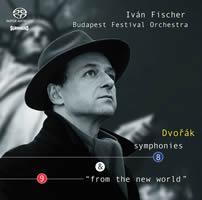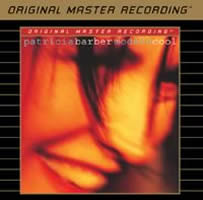Through a Format Darkly
|
[These reviews first appeared in http://www.dagogo.com/. With thanks to Dagogo’s publisher, Constantine Soo, for permission to post them here. M.S.] Through a Format Darkly Mike Silverton [December 2003.]
Antonin DVORAK: Symphony No. 9 in E minor, op. 95, “From the New World.” Symphony No. 8 in G major, Op. 88. Budapest Festival Orchestra, Iván Fischer (cond.). Clive Bennett, executive producer; Hein Dekker, producer and balance engineer; Roger de Schot, recording engineer. Philips SACD 470 617-2 (http://www.deccaclassics.com/). Patricia BARBER: Modern Cool. Patricia Barber, piano, vocals, table knives on strings; Michael Arnopol, bass; John McLean, guitar; Mark Walker, drums, percussion, prepared kit, tin can-o-phone; Dave Douglas, trumpet; Jeff Stitely, udu; Choral Thunder Vocal Choir. Michael Friedman, executive producer; Patricia Barber, producer; Jim Anderson, recording and mixing. Mobile Fidelity Sound Lab UDSACD 2003 (http://www.mofi.com/). What follows is a skewed report. I propose to discuss how the compact disc’s (perhaps) successor, the Super Audio Compact Disc (SACD), sounds not at its full-fledged best but rather in terms of its compatibility via a two-channel, CD-only system. If the reader finds himself in a similar bind, which is to say, proscribed by circumstance to CD-only play (vinyl being beyond our concerns), he’ll probably want to read on. The rest of you can water the house plants. First, your reporter’s two-channel system: Wilson WATT / Puppy 6 speakers; Mark Levinson No. 390S CD player, upgraded from a No. 39; Mark Levinson No. 33H mono amplifiers, one pair; Harmonix Reimyo ALS-777 Line Stabilizer with two Harmonix Studio Master power cords; RS Audio Pure Palladium balanced interconnects; Nordost Valhalla speaker cables; Silent Running Audio acoustic isolation platforms under the electronics; and finally, at the WATTs’ binding posts, two Walker Audio Ultimate High Definition Links. The ML 390S has its own good volume control, therefore no preamp. For reviews of some of the above, see my comments at UltraAudio.com. Let’s begin with a disappointment. The Philips’ tray card tells us that “SACD Surround-Sound requires [a] multi-channel SACD player and compatible surround-sound system. SACD stereo requires [an] SACD player. CD audio can be played on standard CD players. A 6-channel DSD recording.” (I added three hyphens and the bracketed articles.) This is a Super Audio CD in Surround, recorded in Direct Stream Digital, DSD. Dvorak’s eighth and ninth symphonies have been done on recording to a fare-thee-well, the “New World” especially. The competition notwithstanding — much of it great — Iván Fischer and the Budapest Festival Orchestra turn in perfectly fine and spirited performances, which, I regret to say, I cannot listen to with anything resembling happiness. The “CD Audio,” two-channel iteration has nothing to recommend it. Sweet, richly textured, lifelike strings remain the touchstone of a symphonic production, as does a convincingly dimensioned soundstage within which we perceive the various instrumental groups as firmly arrayed. I’ve heard the Budapest Festival Orchestra on other recordings and can report that the present release’s harsh, steely sound and its soundstage’s rather shallow depth is perhaps the fault of the CD mix-down (or whatever) and not that of this fine band and its good conductor. How the disc plays as a six-channel SACD is for another reviewer to say. My fellow Neanderthals are advised to seek elsewhere. (I’ve rendered Dvorak without accent marks. With apologies to purists, the hachek — the inverted chevron capping the “r” — doesn’t travel well over the Internet.) On, then, to better news. The CD-compatibility of Mobile Fidelity Sound Lab’s two-channel SACD, Patricia Barber / Modern Cool, is a pleasure of its kind. This is an assigned disc, not the kind of thing I would normally listen to. But an outsider’s perspective can be useful. That at least is my lame excuse. It’s clear that Patricia Barber is a consummate musician: an accomplished, hugely stylish vocalist, fine pianist and composer. Eight of the program’s 13 numbers are hers. With respect to “table knives on strings” (see headnote), I remain mute, having nothing to compare. The ensemble is likewise first rate. If smooth and sultry, meticulously executed takes on classic pop (“You and the Night and the Music,” “Light My Fire,” “She’s a Lady,” etc.) along with Barber’s own engaging numbers are your musical meat and potatoes, you’re well advised to make your move, even if, again like me, you’ve an obsolescent player. (Modern Cool reached CD in 1998; the SACD adds “The Fool on the Hill” to the original program.) Am I being entirely straightforward with respect to obsolescence? I haven’t the courage to say. One wants not to be the guy people quote at some point in the future as the perfect example of a knee-jerk reactionary. On the other hand, on listening to this MFSL CD-only “compromise,” one wonders how much better the SACD version can be. Well, let’s say it is. You’ll be even more impressed by the disc’s opening moments as Michael Arnopol’s bass pins you to your armchair. And that brings me back to “a pleasure of its kind.” Jim Anderson, the recording engineer, is good at what he does. The insert includes Anderson’s remarks about a microphone wonderfully suited to Barber’s voice. In acknowledging Anderson’s expertise — and this is in all respects an exemplary production — I’m also bound to observe that his craftsmanship is of a style I don’t especially like or often listen to. Let’s call it the gilded-lily school of recording. Barber is often in the listener’s face. It’s as if you can smell the lady’s breath, which I’ve little doubt is also alluring. Elsewhere, the acoustic shifts to a more resonant space, though the sessions took place in one, not several — electronic legerdemain! Were Barber in general a tad removed, her sibilants would be less pronounced. Similarly, the ensemble is beyond luscious, as in Arnopol’s abovementioned bass. I’ve heard productions truer to life, and yet I’m in no way convinced that a strict verisimilitude is what the vocalist and her team sought. Now I do understand that the qualities I remark in mildly critical terms are pleasing to certain thoroughly discriminating audiophiles, and who’s to say them nay? Recording traffics in flavors. Because I prefer vanilla should in no way turn you off to an attractive release. Further and to repeat, I’m commenting on an SACD’s CD-compatible version, which is in and of itself unfair. [More Mike Silverton]
[Previous Article:
Tales of Two Cultures: Hashimoto and Hosokawa]
[Next Article:
A Pianist's Thoughts on Schumann: Symphonic Etudes, Op. 13]
|

